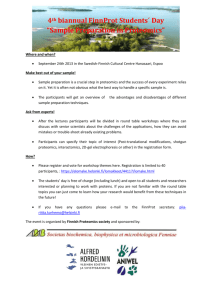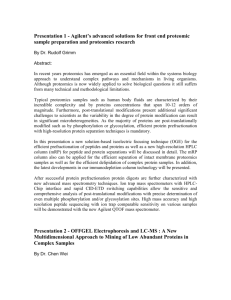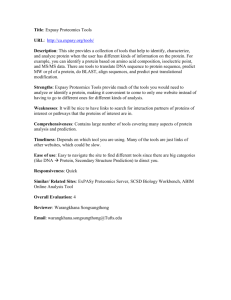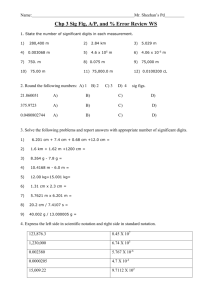PPT Version - OMICS International
advertisement
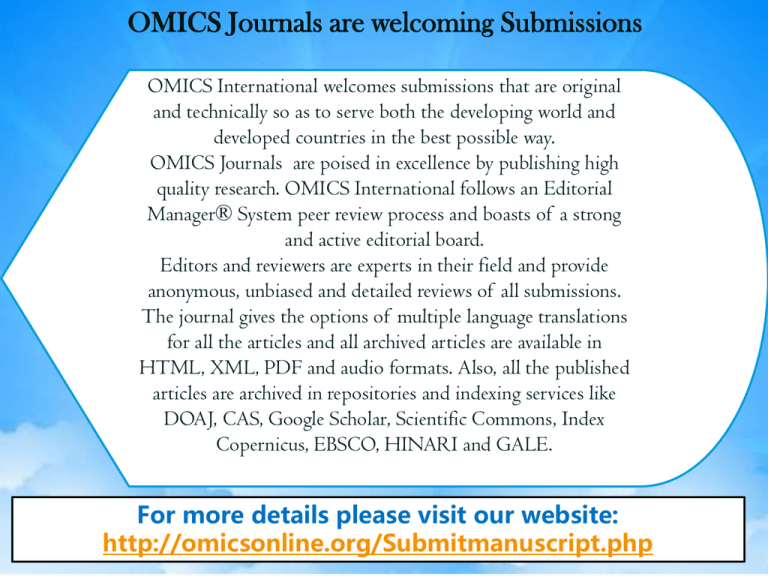
OMICS Journals are welcoming Submissions OMICS International welcomes submissions that are original and technically so as to serve both the developing world and developed countries in the best possible way. OMICS Journals are poised in excellence by publishing high quality research. OMICS International follows an Editorial Manager® System peer review process and boasts of a strong and active editorial board. Editors and reviewers are experts in their field and provide anonymous, unbiased and detailed reviews of all submissions. The journal gives the options of multiple language translations for all the articles and all archived articles are available in HTML, XML, PDF and audio formats. Also, all the published articles are archived in repositories and indexing services like DOAJ, CAS, Google Scholar, Scientific Commons, Index Copernicus, EBSCO, HINARI and GALE. For more details please visit our website: http://omicsonline.org/Submitmanuscript.php Brief Biographic Sketch of Prof David Sheehan BSc PhD DSc Head of School of Biochemistry and Cell Biology, University College Cork, Ireland Science BSc in Biochemistry, University College Cork, 1980 (First class Hons) PhD Biochemistry, Trinity College Dublin, 1985 DSc (advanced doctorate) on published work, National Universityof Ireland, 2009 Expert in protein biochemistry, isolation, characterization Glutathione transferases, heat shock and other stressresponse proteins Research: • Redox proteomics • Ecotoxicology 111 peer-reviewed papers (h-index = 31) 4 books including Physical Biochemistry: Principles and Applications (Wileys, 2nd edition) Supervised 17 PhDs and 19 MScs External examiner (18 PhDs) Spain, UK, Ireland, Sweden, Norway, Portugal, France Editorial Boards: International Journal of Proteomics, Drug Testing and Analysis, Toxins, (Assoc. ed) Journal of Integrated – Omics; Journal of Proteome Science and Computational Biology; (Assoc. ed) J. Biochem. Pharmacol. Res. Research Interests Redox proteomics Proteins absorb most reactive oxygen species during oxidative stress. This damages proteins and changes them covalently thus leading to biochemical consequences. We use a redox proteomics toolkit to explore what proteins are targeted by OS in various situations including in diseases such as hypertension. Ecotoxicology Sentinel species can give information on the quality of their environment. We use bivalves as bioindicators of aquatic toxicology. Our redox proteomics toolkit reveals what biochemical processes are targeted. We are especially interested in nanomaterials and pharmaceuticals as emerging categories of aquatic pollutants. Recent Publications (2014) Sellami, B., Louati, H., Khazri, A., Mezni A., Dellali, M., Aissa, P., Ezzeddine M., Beyrem, H., Sheehan D. (2014) Effect of Permethrin, Anthracene and mixture exposure on shell components, enzymatic activities and protein status in the Mediterranean clams Venerupis decussata. Aquatic Toxicology IN PRESS. Rainville L.-C., Varela, A.C., Sheehan, D. (2014) Application of the redox-proteomics toolbox to Daphnia magna challenged with model prooxidants copper and paraquat. Environmental Toxicology and Chemistry. IN PRESS Ilyas S., Rehman A., Coelho Varela A., Sheehan D. (2014) Redox proteomics changes in the fungal pathogen Trichosporon asahii on arsenic exposure: Identification of protein responses to metal-induced oxidative stress in an environmentally-sampled isolate. PLoS One 9, e-102340 Trevisan, R., Delapedra, G., Mello D.F., Arl, M., Schmidt, E.C., Bouzon, Z.L., Fisher, A., Sheehan, D., Dafre, A.L. (2014) Gills are an initial target of zinc oxide nanoparticles in oysters Crassostrea gigas, leading to mitochondrial disruption and oxidative stress. Aquatic Toxicology,153, 27-38. (http://dx.doi.org/10.1016/j.aquatox.2014.03.018) Cole C, Coelho AV, Sheehan D. (2014) Proteomic responses to metal-induced oxidative stress in hydrothermal vent-living mussels, Bathymodiolus brevior, on the Southwest Indian Ocean vent. Marine Environmental Research, 96, 29-37. Sellami, B., Khazri, A., Louati, H., Boufahja F., Dellali, M., Sheehan D., Aissa, P., Ridha Driss, M., Mahmoudi, E., Beyrem, H. (2014) Effects of permethrin on biomarkers in the Mediterranean clam Ruditapes decussatus. Bulletin of Environmental Contamination and Toxicology. 92, 574-578. Hu, W., Culloty, S., Darmody, G., Lynch, S., Davenport, J., Ramirez-Garcia, S., Dawson, K.A., Lynch, I., Blasco, J., Sheehan, D. (2014) Toxicity of copper oxide nanoparticles in the blue mussel, Mytilus edulis. Chemosphere 108, 289-299. Karlsen, O.A., Sheehan, D., Goksøyr A. (2014) Alterations in the Atlantic Cod (Gadus morhua) hepatic thiol-proteome after methylmercury exposure, Journal of Toxicology and Environmental Health, Part A: Current Issues 77, 650-662, Sellami, B., Mahmoudi, E., Dellali, M., Aissa, P., Coelho, A.V., Sheehan, D. (2014) Effects of permethrin exposure on antioxidant enzymes and protein status in Mediterranean clams Ruditapes decussatus. Environmental Science and Pollution Research. 21, 4461–4472. Rainville L.-C., Carolan D, Varela, A.C., Doyle, H., Sheehan, D. (2014) Proteomic evaluation of citrate-coated silver nanoparticles toxicity in Daphnia magna. The Analyst 139, 1678-1686. Allocati, N., Masulli, M., Del Boccio, P., Pieragostino, D., D’Antonio, D., Sheehan, D., Di Ilio C. (2014) Identification of an elongation factor 1Bg protein with glutathione transferase activity in both yeast and mycelial morphologies from human pathogenic Blastoschizomyces capitatus. Folia Microbiologica 59, 107-113. Schmidt W., Rainville L.-C., McEneff G., Sheehan D., Quinn B. (2014) A proteomic evaluation of the effects of the pharmaceuticals diclofenac and gemfibrozil on marine mussels (Mytilus spp.). Evidence for chronic sublethal effects on stress-response proteins. Drug Testing and Analysis. 6, 210-219. Karmous, I., Chaoui, A., Crinelli, R., Scoccianti, V., Sheehan, D., Jaouani, K., El Ferjani, E. (2014) Role of the ubiquitin-proteasome pathway and some peptidases during seed germination and copper stress in bean cotyledons. Plant Physiology and Biochemistry 76, 77-85. Books Nanoparticles Materials in a size range, with at least one dimension between 1-100nm. (SCENHIR 2005; Moore 2006). Globular Tubular Complex geometries Size determined by TEM for gold nanoparticles (~5nm) EFFECTS OF NANOPARTICLES THEY CAN CROSS BIOBARRIERS OFTEN THEY DAMAGE ORGANELLES ESPECIALLY MITOCHONDRIA ACCUMULATE IN LYSOSOMES? THEY CAN BE COATED WITH PROTEINS THEY OFTEN TRIGGER OXIDATIVE STRESS A New Toxicology? WHAT IS MEANT BY DOSE IN THIS CONTEXT? HOW TO CONTROL FOR LEACHING OF METALS FROM NPs? HOW TO MODEL PARTITIONING? IN ENVIRONMENTAL COMPARTMENTS IN TISSUES IN CELLS RISK ASSESSMENT? IS ANOTHER ASBESTOS LURKING? WILL THE POLLUTER REALLY PAY? THE OXYGEN PARADOX OXYGEN IS ESSENTIAL FOR AEROBIC METABOLISM BUT PRODUCES TOXIC REACTIVE OXYGEN SPECIES (ROS) PHOTOSYNTHETIC CYANOBACTERIA ORIGIN OF EARTH 4,500 MYA APPEARANCE OF MOLECULAR O2 ENDOSYMBIOSIS 3,800 MYA REDUCED ENVIRONMENT OZONE (O3) LAYER 2,500 MYA OXIDISED ENVIRONMENT PRESENT ROS ARE HIGHLY REACTIVE WITH BIOMATERIALS IN MANY CASES, ROS REACTIONS ARE ONLY LIMITED BY RATE OF DIFFUSION – THEY REACT VERY QUICKLY BIOMATERIALS CAN ABSORB ROS (e.g. .HO) •DNA (6%) •RNA (7%) •PROTEINS (69%) •SMALL MOLECULES (18%) PROTEINS ARE THEREFORE KEY TARGETS FOR ROS PROTEOMICS: DISCOVERY-LED APPROACH TO BIOMARKERS 2DE GELS CAN BE DIGITALISED - IMAGE ANALYSIS REDOX PROTEOMICS PROTEINS CAN BE COVALENTLY MODIFIED BY ROS/RNS O H N NITROSYLATION OF TYROSINES CH O H N C CH CH2 C CH2 CARBONYLATION N OH OH OH O HN OXIDATION OF CYSTEINE THIOLS O O C C CH HN CH CH 2 CH 2 H2C H2C NH 2 C H2 H2C CH Aminoadipic acid semialdehyde Lysine O O H2C O C N N Proline 2-Pyrrolidone O O C C CH NH CH H2C HN H2N CH 2 CH 2 H2C O CH 2 CH C NH Arginine Glutamic semialdehyde NH Thiol groups and oxidative stress SO3H SH Proteins 50-75% SO2H SH ROS SH SH SOH SH or S-S-R SH Carbonylation DNPH -O- + DNPH O= PRT PRT ANTI-DNP ECL DNPH DNPH -O- -OANTI-IgG PRT PRT Mussels treated with copper nanoparticles – copper accumulates in gill as dose >s. Gill Mantle Digestive Gland Mussels treated with copper nanoparticles –thiols are oxidised (< IAF) and carbonylated (> FTSC) Selection of proteins with thiol groups - shotgun proteomics Ctrl GNP CdCl2 Digestive gland protein extracts + Activated thiol sepharose DTT @ Thiol- proteins R-SH R-SH Daphnia magna exposed to CuO NPs CONCLUSIONS • NANOPARTICLES CAN ENTER ORGANISMS AND CROSS BIOBARRIERS • THEY FREQUENTLY TRIGGER OXIDATIVE STRESS • OFTEN, CYTOSKELETAL OR STRESS-RESPONSE PROTEINS ARE TARGETS • GEL-BASED AND GEL-FREE PROTEOMICS OFFER ROUTES TO TARGET IDENTIFICATION Journal of Proteomics & Bioinformatics Related Journals Transcriptomics: Open Access Journal of Pharmacogenomics & Pharmacoproteomics Journal of Data Mining in Genomics & Proteomics For more details on Conferences Related Journal of Proteomics & Bioinformatics please visit: http://www.conferenceseries.com/bioc hemistry-meetings Open Access Membership with OMICS International enables academicians, research institutions, funders and corporations to actively encourage open access in scholarly communication and the dissemination of research published by their authors. For more details and benefits, click on the link below: http://omicsonline.org/membership.php

